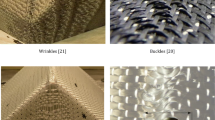Abstract
The influence of shear strength properties and fibre misalignment on the compressive behaviour of unidirectional glass fibre-polypropylene laminates has been examined. Tests were conducted between 20°C and 120°C to provide variation in the constitutive behaviour of the polymer matrix and consequently variation in the support provided to the glass fibres. It was found that the laminate loses strength as the operating temperature increases and failure occurs due to fibre microbuckling. At temperatures higher than 50°C the failure mode switches from in-plane to out-of-plane microbuckling. As the test temperature increases the shear strength and stiffness of the resin are considerably reduced; this decreases the amount of side support for the fibres and reduces the strain level at which fibre buckling initiates. Growth of this damage requires little additional load, suggesting that compression strength is controlled by initiation, rather than propagation of microbuckling. Fracture characteristics have been identified using optical and scanning electron microscopy. Recent theoretical models have been employed to predict the compressive stress-strain response and strength.
Similar content being viewed by others
References
Hahn, H. T. and Sohi, M. M., ‘Buckling of a Fibre Bundle Embedded in Epoxy’,Composites Science and Technology 27, 1986, 25–41.
Harper, J. F. and Heumann, T. O., ‘Failure Mechanisms in Uniaxial Compression in Fibre Composites’, in4th International Conference on Fibre Reinforced Composites, Proceedings of the Institution of Mechanical Engineers, 1990, pp. 231–235.
Soutis, C., ‘Measurement of the Static Compressive Strength of Carbon Fibre/Epoxy Laminates’,Composites Science and Technology 42, 1991, 373–392.
Soutis, C. and Turkmen, D., ‘High Temperature Effects on the Compressive Strength of Glass Fibre-Reinforced Composites’, in A. Miravete (ed.),ICCM-9, Composites Properties and Applications, Vol. VI, Madrid, Spain, 1993, pp. 581–588.
Rosen, B. W., ‘Mechanics of Composite Strengthening’,Fibre Composite Materials, American Society of Metals, 1965, 37–75.
Chung, W. and Testa, R. B., ‘The Elastic Stability of Fibres in a Composite Plate’,J. Composite Materials 3, 1969, 58–80.
Argon, A. S., ‘Fracture of Composites’,Treatise on Materials Science and Technology, Vol. 1, Academic Press, New York, 1972, 79–114.
Evans, A. G. and Adler, W. F., ‘Kinking as a Mode of Structural Degradation in Carbon Fibre Composites’,Acta Metallurgica 22, 1977, 725–738.
Budiansky, B., ‘Micromechanics’,Computer and Struct. 16(1–4), 1982, 3–12.
Steif, P. S., ‘A Model for Kinking in Fibre Composites — I, II’,Int. J. Solid Structures 26, 1990, 549–569.
Curtis, P. A., ‘CRAG Test Methods for the Measurement of the Engineering Properties of Fibre-Reinforced Plastic’, RAE Technical Report 85099, 1985.
Soutis, C., Turkmen, D. and Morrison, C. J., ‘Compressive Fracture of Unidirectional Composites at Elevated Temperatures Using Untabbed Specimens’, in P. J. Hogg, K. Schulte and H. Wittich (ed.),European Conference on Composites Testing and Standardisation, ECCM-CTS 2, Hamburg, Germany, 1994, pp. 169–178.
Berg, C. A. and Salama, M., ‘Fatigue of Graphite Fibre-Reinforced Epoxy in Compression’,Fibre Science and Technology 6, 1973, 725–738.
Hahn, H. T.,Compression Failure Mechanisms in Composite Structures, NASA CR-3988, 1986.
Shuart, M. J.,Short Wavelength Buckling and Shear Failures for Compression Loaded Laminates, NASA TM-87640, 1985.
Haeberle, J. G. and Matthews, F. L., ‘Compression Test Methods for Composites and Theories Predicting the Compressive Strength of Unidirectional CFRP’,Applied Solid Mechanics 3, 1989, 66–79.
Budiansky, B. and Fleck, N. A., ‘Compressive Kinking of Fibre Composites: A Topical Review’,Applied Mechanics Reviews 47(6), Part 2, June 1994, S246-S270.
Batdorf, S. B. and Ko, R. W. C., ‘Stress-Strain Behaviour and Failure of Uniaxial Composites in Combined Compression and Shear, Parts I and II’, Internal Report, School of Engineering and Applied Science, Univ. of California, June 1987.
Lager, J. B. and June, R. R., ‘Compressive Strength of Boron/Epoxy Composites’,J. Composite Materials 3(1), 1969, 48–56.
Ewins, P. D., Tensile and Compressive Test Specimens for Unidirectional Carbon Fibre-Reinforced Plastic’, RAE Technical Report 71217, 1971.
Piggott, M. R. and Harris, B., ‘Compression Strength of Carbon, Glass and Kevlar-49 Fibre-Reinforced Polyester Resins’,J. Mat. Sci. 15, 1980, 2523–2538.
Budiansky, B. and Fleck, N. A., ‘Compressive Failure of Fibre Composites’,J. Mech. Phys. Solids 41, 1993, 183–211.
Fleck, N. A., Deng, L. and Budiansky, B., ‘Prediction of Microbuckle Width in Fibre Composites’, Harvard University Report MECH-203, 1993.
Slaughter, W. S., Fleck, N. A. and Budiansky, B., ‘Microbuckling of Fibre Composites: The Roles of Multi-Axial Loading and Creep’,J. Engng. Mats. and Technology 115(3), 1993, 308–313.
Slaughter, W. S. and Fleck, N. A., ‘Microbuckling of Fibre Composites with Random Initial Fibre Waviness’, to appear inJ. Mech. Phys. Solids, 1995.
Haberle, J. G. and Matthews, F. L., ‘A Micromechanics Model for Compressive Failure of Unidirectional Fibre-Reinforced Plastics’,J. Comp. Materials 28(17), 1994, 1618–1639.
Saunders, D. E. J. and Soutis, C., ‘The Shear and Compressive Behaviour of Low Temperature Cured CFRP Laminates, in3rd Int. Conf. on Deformation and Fracture of Composites, The Institute of Materials, Guildford, UK, 27–29 March 1995, pp. 26–35.
Author information
Authors and Affiliations
Rights and permissions
About this article
Cite this article
Soutis, C., Turkmen, D. Influence of shear properties and fibre imperfections on the compressive behaviour of GFRP laminates. Appl Compos Mater 2, 327–342 (1996). https://doi.org/10.1007/BF00564572
Received:
Accepted:
Issue Date:
DOI: https://doi.org/10.1007/BF00564572




